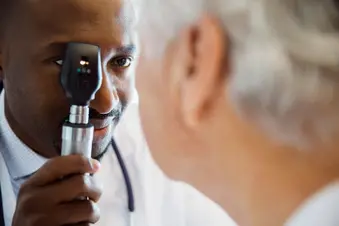
Diabetic macular edema (DME) often doesn't cause noticeable symptoms, so you might not know you have it. Getting regular eye exams can help catch it early and hopefully prevent long-term damage to your vision.
At Home
You can check your eyes with an Amsler grid. It's a simple chart with lines and a dot in the center. Look at the chart with one eye closed and then the other.
When you have DME, the lines might look wavy instead of straight.
This doesn't replace an eye exam by your doctor, but it can tip you off to trouble.
Eye Exams
It's best to see an eye doctor (an ophthalmologist or an optometrist) who's trained to diagnose and treat people with diabetes.
First, you'll probably have visual acuity testing to check for vision loss. The doctor uses a series of eye charts to find out how well you see at different distances.
Before a dilated (slit-lamp) eye exam, your doctor will use eyedrops to make your pupils bigger (dilated). This lets in more light so it's easier for them to see inside your eye. Then your doctor looks at the retina – the place at the back of your eye where light hits – for problems like leaking blood vessels and swelling. They can also spot bleeding in your macula. That's the part of your retina that gets damaged by DME.
Retinal imaging takes pictures of the back of your eye and sends them to a computer, where an eye doctor checks them for signs of disease. This doesn't take the place of a full eye exam. But it can be a good way to start if you don't live near a doctor trained to diagnose DME.
Tests for DME
If your doctor suspects you have DME, you might have fluorescein angiography to look at the blood vessels in your retina. Your doctor injects a special dye into a vein in your arm. It quickly goes to your eye, where it makes blood vessels show up on digital photos.
Optical coherence tomography (OCT) is one of the best ways to test for DME. It's like an ultrasound, but it uses light waves instead to create very fine, detailed images of tissues inside your eye.
OCT can show the thickness of different layers in your retina and find problems that other tests can't.
When to Have Your Eyes Checked
If you have type 1 diabetes, it takes a few years for eye problems to show up. Get your first eye exam within 5 years of finding out you have diabetes.
Get an eye exam soon after getting diagnosed with type 2 diabetes. You may already have DME and not know it. It may take a few years for eye problems to show up, but you should still have an eye exam within a few months to a year of getting diagnosed.
Whether you have type 1 or type 2 diabetes, you should get your eyes checked before you try to get pregnant, or in the first trimester if you're already pregnant. You may need more eye tests during your pregnancy and after your baby is born. Being pregnant can raise the odds of DME and make eye problems you already have worse.
Generally speaking, you'll need an eye exam every year, or maybe once every 2 years if you don't have diabetic retinopathy. Once you've been diagnosed with an eye disease, your doctor may want to see you more often.
Show Sources
Photo Credit: iStock / Getty Images
SOURCES:
American Academy of Ophthalmology: "Macular Edema Symptoms."
Review of Optometry: "Dissecting DME: A clinician's role in diagnosing and managing diabetic macular edema."
National Eye Institute: "Facts About Macular Edema," "Facts About Diabetic Eye Disease."
Diabetes Care: "Diabetic Retinopathy: A Position Statement by the American Diabetes Association."
Neoplasia: "Optical Coherence Tomography: An Emerging Technology for Biomedical Imaging and Optical Biopsy."